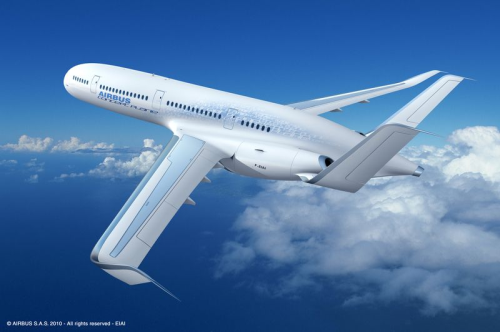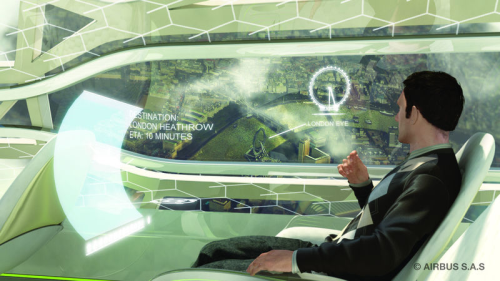

The Airbus Concept Place embodies what air transport could look like in 2050, or earlier if existing technologies advance faster than expected. It brings together a package of technologies, which although feasible, are unlikely ever to coexist in this manner. In reality, engineers have to find the best balance of technologies, depending on what the priorities are.
The Airbus Concept Plane features long, slim wings, semi-embedded engines, a U-shaped tail and lightweight 'intelligent' body, all designed to improve environmental performance or 'eco-efficiency.' The objective is lower fuel burn, significantly reduced emissions, less noise and greater comfort.
These are its main features.
Fuselage
The fuselage is no longer a simple tube. It is curved and shaped to provide more internal space, with better aerodynamics outside to improve flight. The fuselage and entire aircraft structure is manufactured entirely from composite to take advantage of the easy-to-shape characteristics of the material.
Manufacturing methods
New manufacturing methods will reduce the cost and environmental impact of building the aircraft despite the new advanced materials and complex shapes.
Configured wingspan
Longer, slimmer wings glide better through the skies, as the flow of air over the wing surface reduces drag, and in turn, improves fuel efficiency.
Intelligent materials
New lightweight 'smart' materials sense the load they are under, making for a lighter aircraft that draws less fuel and curbs emissions.
Engines
Engines will be more reliable, quieter and fuel-efficient. They are positioned at the rear and semi-embedded to fully optimise the aircraft for lower fuel burn. This engine placement also reduced cabin noise levels. The engines can be incorporated into the aircraft body because technological advances will have reached such a level that superior engine reliability will diminish the need for immediate access to its components.
Doors
Entrance and exit doorways are double doors to allow for faster and easier boarding and disembarking.
Empennage
The empennage (tail section) is U-shaped, acting as a shield to reduce external noise pollution. The concept plane does not use a vertical tail, as seen on the planes of today. Vertical tails are required when engines are installed on the wings as they provide directional stability in case of engine failure. The engines of the future will have no risk of failure, eliminating the need for a vertical tail.
Electrical systems
The electrical system will monitor its own state of health, anticipating any need for maintenance and automatically scheduling this well in advance. Electronics and other systems on board will be entirely self-sufficient, requiring minimum to zero maintenance. ♦
Further information:





